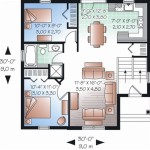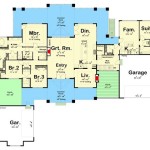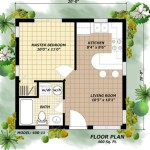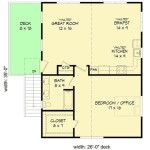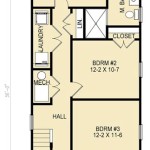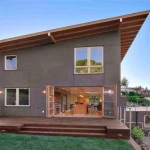Two Bedroom Beach House Plans: Designing Your Coastal Retreat
The allure of a beach house, a sanctuary near the ocean, is undeniable. For many, the dream encompasses a manageable space that provides comfort, functionality, and a strong connection to the surrounding environment. Two-bedroom beach house plans offer an attractive solution, balancing affordability, ease of maintenance, and adequate living space for individuals, couples, or small families. This article will explore the key considerations, design principles, and potential features of two-bedroom beach house plans, providing a comprehensive overview for those contemplating building their own coastal haven.
Understanding the Appeal of Two Bedroom Beach House Plans
Two-bedroom beach houses present several significant advantages. Their relatively smaller size translates to lower construction costs compared to larger homes. This can make the prospect of owning a coastal property more attainable for a wider range of budgets. Reduced square footage also means lower property taxes and insurance premiums, contributing to long-term affordability. Furthermore, a smaller space is easier to maintain, demanding less time and effort for cleaning, landscaping, and general upkeep. This allows homeowners to spend more time enjoying the beach and other recreational activities. The intimacy of a two-bedroom design can also appeal to couples or individuals seeking a cozy and private retreat.
Two-bedroom beach house plans are often more environmentally friendly. Smaller homes generally consume less energy for heating and cooling, reducing their carbon footprint. The limited land requirement also minimizes the impact on the surrounding ecosystem. Thoughtful design can further enhance sustainability by incorporating features such as solar panels, rainwater harvesting systems, and energy-efficient appliances.
These plans can be adapted to a variety of architectural styles, from traditional coastal cottages to modern, minimalist designs. The flexibility allows homeowners to create a space that reflects their personal aesthetic preferences while harmonizing with the surrounding environment. The compact size also facilitates creative design solutions, such as maximizing natural light, incorporating outdoor living spaces, and utilizing multi-functional furniture.
Critical Design Considerations for Coastal Construction
Building a beach house necessitates careful consideration of the unique environmental challenges posed by coastal locations. These challenges include exposure to salt air, high winds, intense sunlight, and potential flooding. Selecting durable, weather-resistant materials is paramount to ensure the longevity of the structure. Materials such as fiber cement siding, pressure-treated lumber, corrosion-resistant fasteners, and impact-resistant windows are crucial for withstanding the harsh coastal environment.
Elevating the house above the base flood elevation is often a requirement in coastal areas and is a prudent measure to protect against water damage. This can be achieved through various methods, including pilings, stilts, or a raised foundation. The specific elevation requirements are typically determined by local building codes and flood zone maps. Proper drainage systems are also essential to manage stormwater runoff and prevent erosion.
Orientation of the house should be carefully considered to maximize natural light and ventilation while minimizing exposure to harsh sunlight and prevailing winds. Strategically positioned windows and doors can capture cooling breezes and reduce the need for air conditioning. Overhangs and awnings can provide shade and protect windows from direct sunlight. Landscaping can also play a role in mitigating the effects of wind and sun, providing natural barriers and creating a more comfortable outdoor environment.
Designing for energy efficiency is particularly important in coastal climates, where heating and cooling costs can be significant. Insulation, high-performance windows, and energy-efficient appliances can substantially reduce energy consumption. Incorporating passive solar design principles, such as orienting the house to maximize solar gain in winter and minimize it in summer, can further improve energy efficiency. The installation of solar panels can provide a renewable source of energy, reducing reliance on fossil fuels and lowering utility bills.
Interior design should also reflect the coastal environment. Light, airy colors, natural materials, and nautical-themed decor can create a relaxed and inviting atmosphere. Durable, easy-to-clean surfaces are practical choices for beach houses, given the potential for sand and moisture to be tracked indoors. Open floor plans can maximize space and create a seamless flow between indoor and outdoor living areas.
Key Features and Layout Options for Two Bedroom Beach House Plans
The layout of a two-bedroom beach house should be carefully planned to maximize functionality and comfort within a limited space. Open floor plans that combine the living room, dining area, and kitchen are popular choices, creating a spacious and airy feel. This design also facilitates social interaction and allows for easy movement throughout the house. The kitchen should be designed with efficiency in mind, featuring ample counter space, storage, and modern appliances.
The bedrooms should be positioned to provide privacy and quiet. Master bedrooms often include ensuite bathrooms and walk-in closets. Guest bedrooms can be designed to accommodate multiple occupants, with features such as bunk beds or convertible furniture. Adequate storage space is crucial in a beach house, where space is often at a premium. Built-in shelves, closets, and storage benches can help to maximize storage without sacrificing living space.
Outdoor living spaces are an integral part of the beach house experience. Decks, patios, and porches provide opportunities for relaxation, dining, and entertaining. These spaces should be designed to take advantage of the views and the surrounding environment. Comfortable outdoor furniture, shade structures, and outdoor kitchens can enhance the functionality and enjoyment of outdoor living areas. An outdoor shower is a practical addition, allowing residents to rinse off sand and saltwater before entering the house.
Consideration should be given to accessibility, particularly for individuals with mobility limitations. Ramps, wider doorways, and accessible bathrooms can make the house more comfortable and usable for people of all ages and abilities. Universal design principles can be incorporated throughout the house to create a safe and convenient living environment.
Flexibility is another important consideration. Multi-functional spaces, such as a guest bedroom that can double as a home office, can maximize the utility of the house. Convertible furniture, such as sofa beds and folding tables, can also provide flexibility and adaptability. The ability to adapt the house to changing needs and lifestyles can extend its usefulness and value over time.
Storage for beach gear, such as surfboards, kayaks, and beach chairs, is essential in a beach house. A dedicated storage area, such as a garage or shed, can keep these items organized and protected from the elements. Outdoor storage boxes can also be used to store smaller items, such as beach towels and toys.
Interior design choices can enhance the overall feeling of spaciousness. Light colours, large windows, and strategically placed mirrors can create the illusion of more space. Minimizing clutter and keeping surfaces clear can also contribute to a more open and airy feel. The use of natural materials, such as wood, stone, and bamboo, can create a warm and inviting atmosphere.
The integration of technology can enhance the convenience and comfort of a two-bedroom beach house. Smart home systems can control lighting, temperature, and security, allowing residents to manage their homes remotely. High-speed internet access is essential for staying connected and working remotely. Entertainment systems, such as outdoor speakers and televisions, can enhance the enjoyment of outdoor living spaces.
Two-bedroom beach house plans offer a compelling option for those seeking a coastal retreat. By carefully considering the design principles, environmental challenges, and potential features, individuals can create a functional, comfortable, and sustainable home that embodies the essence of beach living. The focus should remain on durable materials, efficient layouts, and thoughtful integration of indoor and outdoor spaces to ensure a long-lasting and enjoyable coastal experience.

House Plan 96705 Coastal Style With 2 Bed Bath

Beach House Plan 2 Beds 1 Baths 869 Sq Ft 536

Small Home 2 Bedroom House Plans 117 8rh Beach Haven Nfloorplans

6 Tiny Floor Plans For Delightful 2 Bedrooms Beach Homes Engineering Discoveries

Beach Style House Plan 2 Beds 1 Baths 869 Sq Ft 536 Houseplans Com

Beautiful Beach House Plans Blog Eplans Com

Beach Style House Plan 2 Beds Baths 1110 Sq Ft 45 215

Beautiful Beach House Plans Blog Eplans Com

Beach House Plan With 2 Bedrooms And 5 Baths 1196

Coastal House Beach Floor Plans

